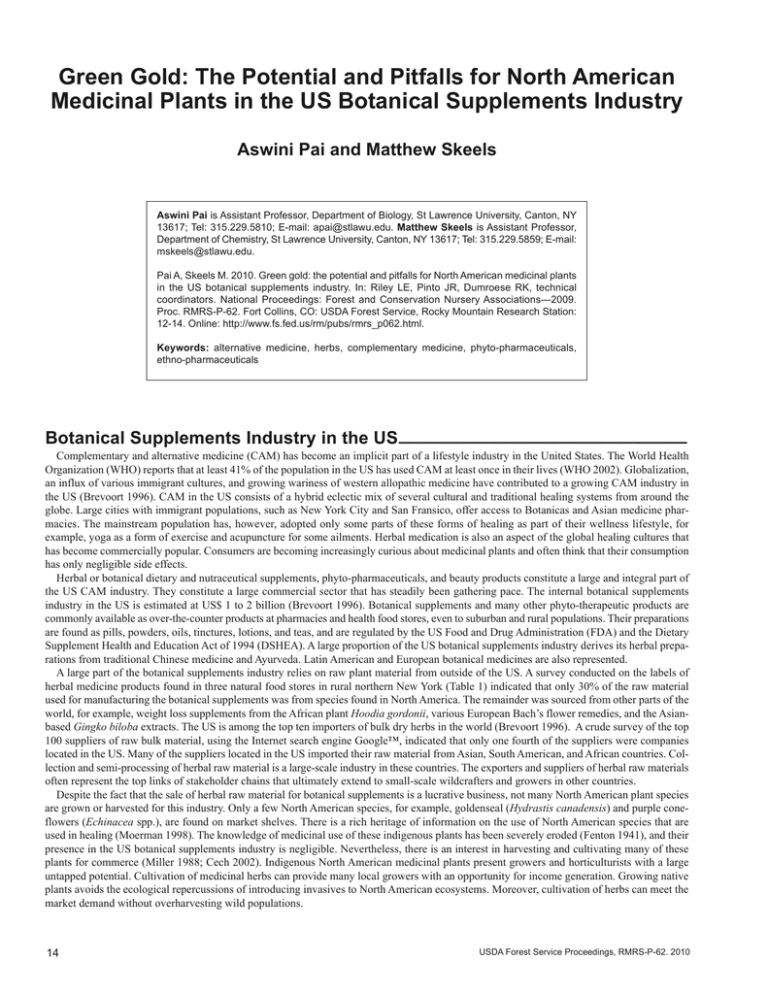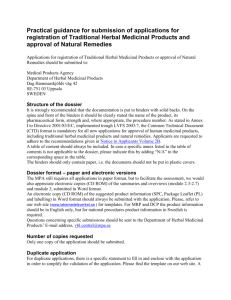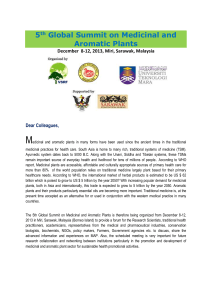Green Gold: The Potential and Pitfalls for North American
advertisement

Green Gold: The Potential and Pitfalls for North American Medicinal Plants in the US Botanical Supplements Industry Aswini Pai and Matthew Skeels Aswini Pai is Assistant Professor, Department of Biology, St Lawrence University, Canton, NY 13617; Tel: 315.229.5810; E-mail: apai@stlawu.edu. Matthew Skeels is Assistant Professor, Department of Chemistry, St Lawrence University, Canton, NY 13617; Tel: 315.229.5859; E-mail: mskeels@stlawu.edu. Pai A, Skeels M. 2010. Green gold: the potential and pitfalls for North American medicinal plants in the US botanical supplements industry. In: Riley LE, Pinto JR, Dumroese RK, technical coordinators. National Proceedings: Forest and Conservation Nursery Associations—2009. Proc. RMRS-P-62. Fort Collins, CO: USDA Forest Service, Rocky Mountain Research Station: 12-14. Online: http://www.fs.fed.us/rm/pubs/rmrs_p062.html. Keywords: alternative medicine, herbs, complementary medicine, phyto-pharmaceuticals, ethno-pharmaceuticals Botanical Supplements Industry in the US ______________________________ Complementary and alternative medicine (CAM) has become an implicit part of a lifestyle industry in the United States. The World Health Organization (WHO) reports that at least 41% of the population in the US has used CAM at least once in their lives (WHO 2002). Globalization, an influx of various immigrant cultures, and growing wariness of western allopathic medicine have contributed to a growing CAM industry in the US (Brevoort 1996). CAM in the US consists of a hybrid eclectic mix of several cultural and traditional healing systems from around the globe. Large cities with immigrant populations, such as New York City and San Fransico, offer access to Botanicas and Asian medicine pharmacies. The mainstream population has, however, adopted only some parts of these forms of healing as part of their wellness lifestyle, for example, yoga as a form of exercise and acupuncture for some ailments. Herbal medication is also an aspect of the global healing cultures that has become commercially popular. Consumers are becoming increasingly curious about medicinal plants and often think that their consumption has only negligible side effects. Herbal or botanical dietary and nutraceutical supplements, phyto-pharmaceuticals, and beauty products constitute a large and integral part of the US CAM industry. They constitute a large commercial sector that has steadily been gathering pace. The internal botanical supplements industry in the US is estimated at US$ 1 to 2 billion (Brevoort 1996). Botanical supplements and many other phyto-therapeutic products are commonly available as over-the-counter products at pharmacies and health food stores, even to suburban and rural populations. Their preparations are found as pills, powders, oils, tinctures, lotions, and teas, and are regulated by the US Food and Drug Administration (FDA) and the Dietary Supplement Health and Education Act of 1994 (DSHEA). A large proportion of the US botanical supplements industry derives its herbal preparations from traditional Chinese medicine and Ayurveda. Latin American and European botanical medicines are also represented. A large part of the botanical supplements industry relies on raw plant material from outside of the US. A survey conducted on the labels of herbal medicine products found in three natural food stores in rural northern New York (Table 1) indicated that only 30% of the raw material used for manufacturing the botanical supplements was from species found in North America. The remainder was sourced from other parts of the world, for example, weight loss supplements from the African plant Hoodia gordonii, various European Bach’s flower remedies, and the Asianbased Gingko biloba extracts. The US is among the top ten importers of bulk dry herbs in the world (Brevoort 1996). A crude survey of the top 100 suppliers of raw bulk material, using the Internet search engine Google™, indicated that only one fourth of the suppliers were companies located in the US. Many of the suppliers located in the US imported their raw material from Asian, South American, and African countries. Collection and semi-processing of herbal raw material is a large-scale industry in these countries. The exporters and suppliers of herbal raw materials often represent the top links of stakeholder chains that ultimately extend to small-scale wildcrafters and growers in other countries. Despite the fact that the sale of herbal raw material for botanical supplements is a lucrative business, not many North American plant species are grown or harvested for this industry. Only a few North American species, for example, goldenseal (Hydrastis canadensis) and purple coneflowers (Echinacea spp.), are found on market shelves. There is a rich heritage of information on the use of North American species that are used in healing (Moerman 1998). The knowledge of medicinal use of these indigenous plants has been severely eroded (Fenton 1941), and their presence in the US botanical supplements industry is negligible. Nevertheless, there is an interest in harvesting and cultivating many of these plants for commerce (Miller 1988; Cech 2002). Indigenous North American medicinal plants present growers and horticulturists with a large untapped potential. Cultivation of medicinal herbs can provide many local growers with an opportunity for income generation. Growing native plants avoids the ecological repercussions of introducing invasives to North American ecosystems. Moreover, cultivation of herbs can meet the market demand without overharvesting wild populations. 14 USDA Forest Service Proceedings, RMRS-P-62. 2010 Green Gold: The Potential and Pitfalls for North American Medicinal Plants in the US Botanical Supplements Industry Country of Origin Percentage of Botanical Materials Albania 1 Australia 1 Bosnia 1 Brazil 1 Bulgaria 3 Canada 3 Chile 3 China 8 Egypt 4 Europe 15 France 1 Hungary 1 India 6 Indonesia 3 Japan 1 Mexico 1 Paraguay 1 Peru 1 Poland 3 Romania 1 South Africa 1 South America 1 Sri Lanka 1 Thailand 1 Turkey 1 United States 28 Vietnam 1 East Meets West: Eastern Medicine and Western Plants _______________ The geological history of North America and temperate Asia has resulted in several congeneric species. About two thirds of the North American taxa have Asian relatives, and overlap in the phytochemistry of many of these Asian and North American congeneric species is significant (Li 2002a). It is plausible to examine the usefulness of North American species for some of the Asian phyto-pharmaceuticals. However, this concept does require additional research. The use of North American species in Chinese medicine is not a novel idea. American ginseng (Panax quiquifolium), a Native American medicinal species, has been used as a substitute for its overharvested Asian congener Panax ginseng, a popular adaptogen in traditional Chinese medicine since the early 20th century. At one point, American ginseng was threatened with over harvest to meet its export demand. It was listed in the Convention for International Trade in Endangered Species (CITES) and its global trade was regulated. Currently, the US Fish and Wildlife Service (USFWS) monitors harvest of North American ginseng by requiring wildcrafters to buy permits for harvesting the USDA Forest Service Proceedings, RMRS-P-62. 2010 species. At the same time, horticulturists have been able to determine optimal conditions for cultivating the species (Anderson and others 2002; Cech 2002; Hsu 2002; Li 2002b), thus subverting the pressure from wild populations. The demand for North American ginseng can be met sustainably through cultivation of the species. Sometimes, North American species might offer better quality of raw material as compared to their Asian counterparts. For example, sweetflag (Acorus calamus) is a medicinal and aromatic wetland species that is ubiquitously distributed through Asia, North America, and Europe. Historically, the plant might have been spread by humans along trade and hunting trails. Its rhizome is currently of ethno-pharmaceutical relevance to several cultures and is used on a commercial scale in the global perfume industry (Motley 1994). The plant is harvested for commercial purposes in South Asia. It is often cultivated from its rhizome on abandoned paddy fields where the soils are marginal and nutrient poor, making it a very low input crop. In North America, however, the species is considered a weed. Because North American varieties of the species have less B-asarone (a carcinogenic compound of concern) as compared to the Asian varieties, sweetflag could be a valuable, albeit untapped, resource in the US. Even though American species can provide many of the phytochemicals found in Asian species (Li 2002a), they remain unexplored as sources of these chemicals. For example, American goldthread (Coptis trifolia) is a forgotten Iroquois medicinal found in the forests of northern New York, and is closely related to the commercially popular goldenseal (from midwestern North America) and Chinese goldthread (Coptis chinensis). Although American goldthread cannot act as a complete substitute of either of the two commercially popular species, it does contain two of the major alkaloids (that is, coptisine and berberine) found in the latter species (Kamath and others 2009). As pharmacologists try to hone in on the silver bullets or phyto-chemicals that display efficacy in healing, North American plants could be a potential source for those found in their Asian congeners. Quality Control and Effort __________ It is important to understand the growing conditions and requirements of many medicinal plants (Cech 2002). Often, medicinal plants might require very little effort to culture. Sweetflag, for example, requires very little care and can be planted on marginal lands. Preliminary observations on goldenseal cultivated on tilled and untilled soil in Ohio indicated no significant difference in biomass sequestered by 7 Harvested Rhizome Biomass Table 1. Product label survey to assess the regional source of botanical materials in supplements found at three natural food stores in rural northern New York. Pai and Skeels 6 5 4 3 2 1 0 Tilled Untilled Soil Treatment Figure 1. Preliminary observations on goldenseal (Coptis spp.) cultivated on tilled and untilled soil in Ohio. 15 Pai and Skeels Green Gold: The Potential and Pitfalls for North American Medicinal Plants in the US Botanical Supplements Industry the plant rhizomes (Figure 1), suggesting that tilling might not be necessary for growing the plant. Medicinal plants such as bloodroot (Sanguinaria canadensis) that are gaining commercial importance are found nurtured and transplanted in many backyard gardens in northern New York. Herbalists and conservation groups such as the United Plant Savers, a US-based plant conservation organization, encourages the propagation of medicinal plants in all kinds of areas, including kitchen gardens, backyards, restoration projects, understorey of private woodlands, agroforests, and the margins of agricultural lands (Gladstar and Hirsch 2000). Microenvironment is an important facet when harvesting or cultivating medicinal plants. Strategic cultivation can enhance the quality of the plant part being harvested. For example, pilot greenhouse studies at St Lawrence University (Canton, NY) indicate that high light conditions can induce the production of greater amounts of the alkaloid berberine in goldenseal rhizomes (Figure 2). Understanding the optimal conditions for growth can increase quality and yield of a medicinal plant. Many North American medicinal plants can be propagated from rhizomes (often referred to by growers as bareroot) as well as seeds. Seed germination and seedling survival can be tricky and uncertain for many medicinal plants. In addition, a long time to maturity can be a limitation when trying to get a crop for economic turnover in a short period of time. Growing plants from rhizome stock is often advantageous because it allows selection and propagation of hardy and better quality genotypes. Rhizomes also require less time to establish and grow as compared to seeds and seedlings. Potential and Pitfalls ______________ Alkaloid content (mg/g plant) material Although North American medicinal plants offer great potential as cash crops, growers have to face some challenges. First, there is a need to popularize botanical medicine that utilizes North American medicinal species. This, however, needs to be done carefully without infringing on the intellectual property rights of Native American groups. Second, small scale growers need to establish marketing links, either directly with companies that produce botanical supplements and ancillary products, or with bulk, large-scale suppliers that deal with this industry. Third, it is important to understand the ecology of these medicinal species and create preemptive sustainable management strategies. Fourth, it is important that optimal growing conditions that yield greater biomass as well as better quality of the plant parts are better understood. Fifth, growers need to gauge North American species as substitutes for other exotic plants. Sixth, growers need to be in tune as new markets and products emerge, for example, North American species that could be sources of phytochemicals for the pharmaceutical industry. If managed well, North American medicinals have the potential to be “green gold” as a commercially viable investment and enterprise for the small-scale grower and farmer. References ______________________ Anderson RC, Anderson MR, Houseman G. 2002. Wild American ginseng. Native Plants Journal 3:93-105. Brevoort P. 1996. The US botanical market—an overview. Herbal Gram 36:49-57. Cech R. 2002. Growing at-risk medicinal herbs, cultivation, conservation and ecology. Williams (OR): HorizonHerbs. Fenton WN. 1941. Contacts between Iroquois herbalism and colonial medicine. Washington (DC): Smithsonian Institution. Annual Report. p 503-526. Gladstar R, Hirsch P. 2000. Planting the future: saving our medicinal herbs. Rochester (VT): Healing Arts Press. 289 p. Hsu P. 2002. Commercial production of American ginseng (Panax quinquefolius L.). Native Plants Journal 3:106-108. Kamath S, Skeels M, Pai A. 2009. Significant differences in alkaloid content of Coptis chinensis (Huanglian), from its related American species. Chinese Medicine 4:17. Li TSC. 2002a. Chinese and related North American herbs: phytopharmacology and therapeutic values. Boca Raton (LA): CRC Press. Li TSC. 2002b. Stratificatoin of American ginseng seeds—problems and solutions. Native Plants Journal 3:109-111. Miller RA. 1988. Native plants of commercial importance: the nomadic life of the professional forager. Grants Pass (OR): Oak Incorporated. Moerman DE. 1998. Native American ethnobotany. Portland (OR): Timber Press. Motley TJ. 1994. The ethnobotany of sweet flag, Acorus calamus (Araceae). Economic Botany 48:397-412. [WHO] World Health Organization. 2002. WHO traditional medicine strategy 2002-2005. Geneva (Switzerland): World Health Organization. 60 50 High light Low light 40 30 20 10 0 Berberine Hydrastine Hydrastinine Figure 2. Berberine (an alkaloid) content of goldenseal rhizomes grown under low and high light conditions in the Johnson Hall of Science greenhouse facility, St Lawrence University, Canton, NY. The content of this paper reflects the views of the authors, who are responsible for the facts and accuracy of the information presented within. 16 USDA Forest Service Proceedings, RMRS-P-62. 2010






